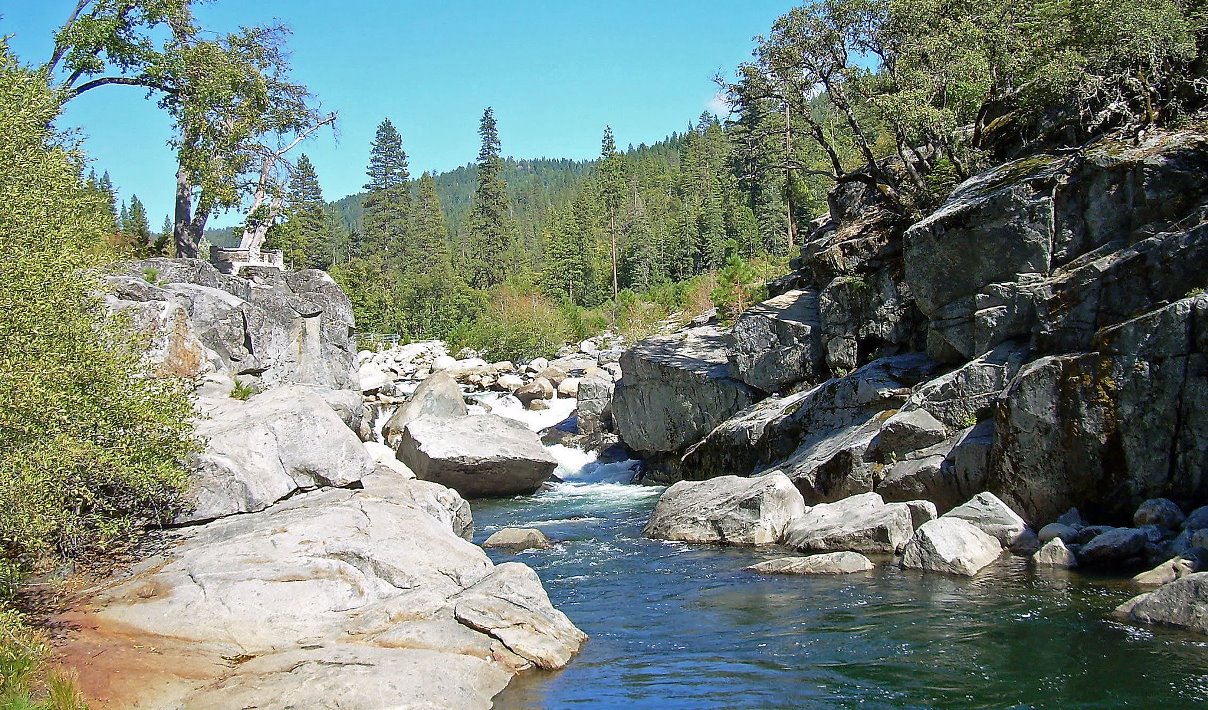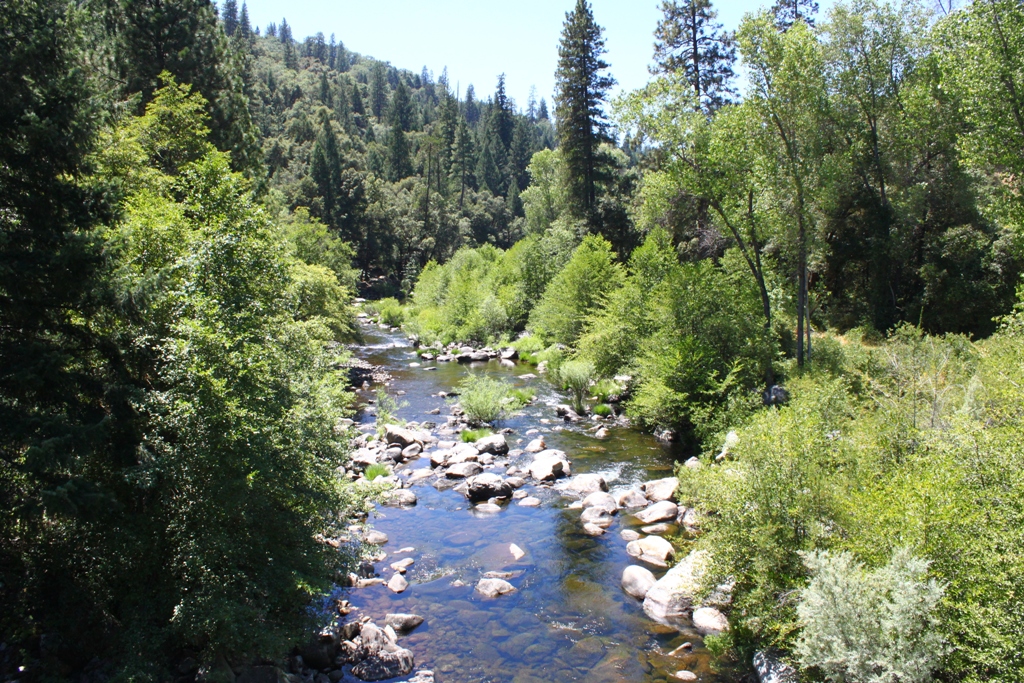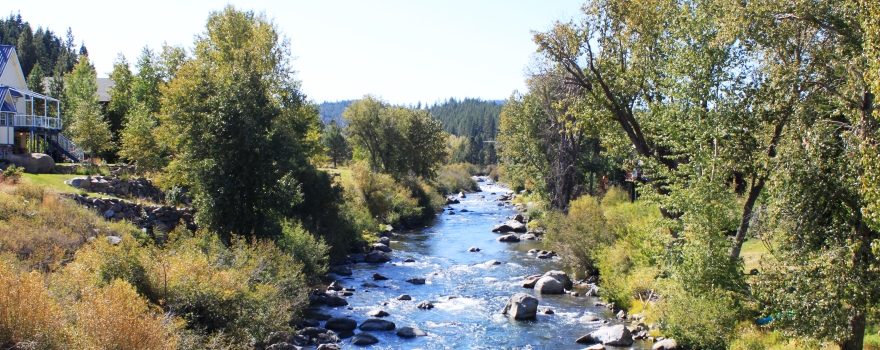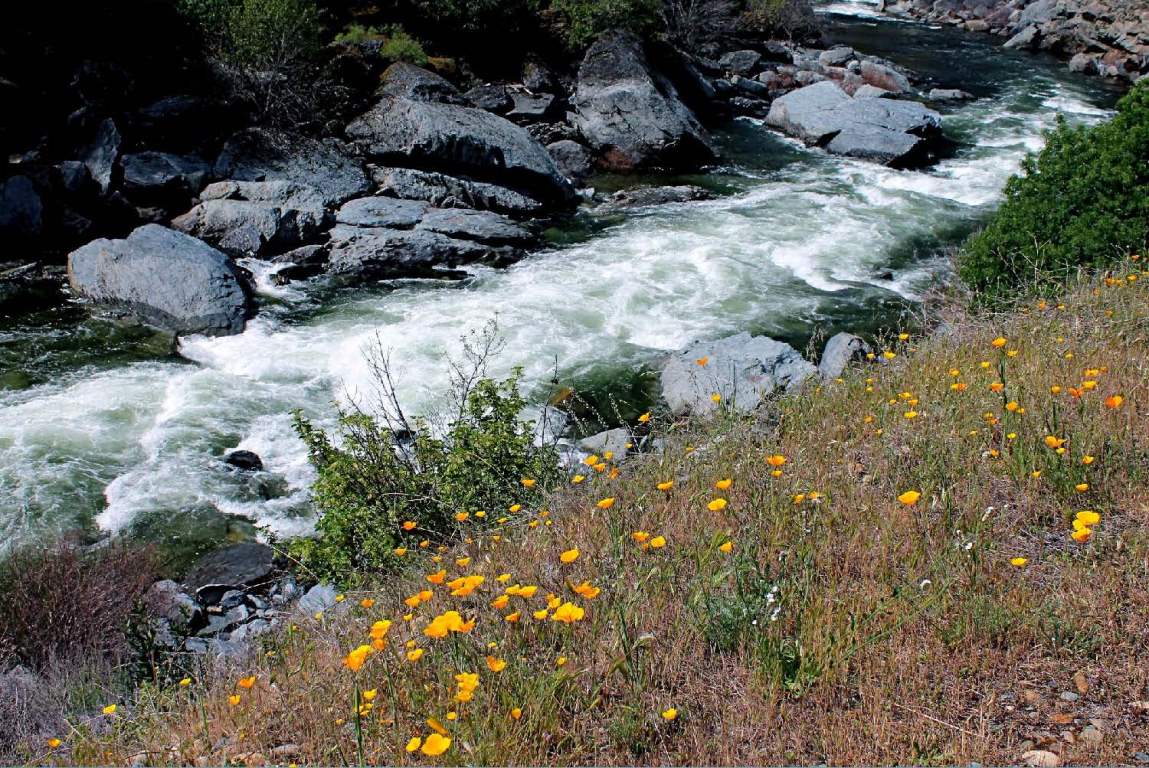Friends of the River co-founder Mark Dubois and current Executive Director Eric Wesselman discuss the protections for California rivers and why they are optimistic for the future
April 22 is Earth Day, which marks the anniversary of the birth of the modern environmental movement that began in 1970 and would soon evolve to provide a voice to the world’s emerging environmental consciousness and elevate environmental concerns in the public dialog. 2020 marked fifty years since the first Earth Day, and to commemorate the occasion, a webinar hosted by the California Lawyers Association brought together long-time environmentalist and co-founder of Friends of the River Mark Dubois with the current organization’s current Executive Director Eric Wesselman to reflect on progress over the past 50 years, look at the laws that protect our rivers and speak of their optimism for the future.
Eric Wesselman began by noting that the Friends of the River was founded almost 50 years ago to save the Stanislaus River, so it was a very placed-based organization at that time to save the river from the New Melones Dam.
“We sort of lost that battle but also won the war in that no major on-river dam has been built in California since,” he said. “It effectively ended the era of big dam building in California, opening the door for new and more creative and innovative water projects to meet our water needs in the 21st century.”
BRIEF OVERVIEW OF CALIFORNIA’S RIVERSCAPE
Mr. Wesselman presented a map (lower, left) of the major rivers in California, noting that there are more rivers in the northern half of the state than the southern half of the state. There are many rivers coming out of the Sierra Nevada mountains, and then there are the North Coast Rivers, the Salmon, the Trinity, the Mad River, and the Eel up there which he described as good ‘juicy’ rivers and watersheds.
The map (upper, right) shows the dams that have been built on the state’s rivers – more than 1300 dams. He noted that these are just the dams that are under the jurisdiction of the state of California and the Department of Water Resources; there are actually many, many more dams than this that are smaller and on private property.
Almost every river in the Sierra Nevada has at least one dam on it. There’s only one significant river without a dam, which is the Cosumnes. In most cases, these rivers have a series of dams much like a staircase: a dam, reservoir, dam, reservoir, dam, reservoir, and so on.
 “It really gives the sense of the magnitude of a pretty built out system that we pursued strategically through the last century,” he said. “We’ve really irrevocably altered the landscape of the state.”
“It really gives the sense of the magnitude of a pretty built out system that we pursued strategically through the last century,” he said. “We’ve really irrevocably altered the landscape of the state.”
Even so, there are plans for new dams. After the last drought, plans for new dams that had been around for decades were dusted off and reenergized to build several new large surface storage projects throughout the state.
“When you look at the cost and add it up, it’s over $10 billion for these reservoirs, so it’s a chunk of money,” said Mr. Wesselman. “Then you look at the yield. How much a reservoir can hold is an irrelevant number. What you want to look at is how much do the engineers think it’s going to actually yield, and if you add up all that for these projects, it’s less than 2% of an increase in our state water supply. So you look at the cost-benefit there. Part of that is because the good sites for dams are taken.”
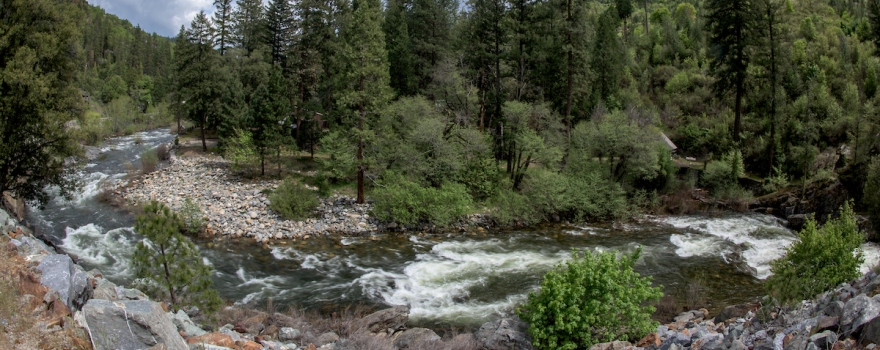
Photo by John Chacon / DWR
WILD AND SCENIC RIVER DESIGNATION
 The first legal hook for protecting rivers is the Wild and Scenic River designation, which is akin to the aquatic version of a wilderness area or a national park. There are two Wild and Scenic River systems: the state and the federal which are similar but not the same. The federal Wild and Scenic Act was passed in 1968; it was followed four years later by the state’s Wild and Scenic Rivers Act.
The first legal hook for protecting rivers is the Wild and Scenic River designation, which is akin to the aquatic version of a wilderness area or a national park. There are two Wild and Scenic River systems: the state and the federal which are similar but not the same. The federal Wild and Scenic Act was passed in 1968; it was followed four years later by the state’s Wild and Scenic Rivers Act.
“The idea here is these laws protect outstanding and remarkable values, and the federal law in statute defines those as scenic, recreational, geologic, fish and wildlife, historic, and cultural values,” said Mr. Wesselman. “California’s version actually whittled the list down.”
The law calls for protecting those values through ensuring their free-flowing state, which includes prohibiting or not building new dams or new diversions or other destructive infrastructure on the stretches of a protected river; it also protects rivers from pollution and runoff.
The federal legislation protects the river in a quarter-mile corridor on either side whereas the state law just protects the bank up to where the river touches the land. The federal statute also requires a river management plan so that there’s a plan in place to manage the river and to ensure those outstanding and remarkable values are indeed protected in perpetuity.
There are three levels of designation:
Wild: this is a river free from impoundment. For example, the higher elevations of the Tuolumne River doesn’t have a lot of human development; there may be a road or two going down for put-ins and take-outs for kayaks and rafters, and a couple of rigorous trails, but that’s about it.
Scenic: This is similar to the wild status, except it tends to more accessible – more roads and more trails, such as the Merced River, which is largely designated as scenic as it leaves the national park and heads down to the valley floor.
Recreational: These are more readily accessible – there are roads, shoreline development, housing, commercial, and industry. These rivers may have been dammed or diverted. The Lower American River that floats through Sacramento is a great example as it has a recreational designation in both the state and the federal systems; this dual designation was described as being a ‘bulletproof’ designation by Mr. Wesselman.
A river gets the Wild and Scenic River designation through an act of Congress or the state legislature. “Typically you’re looking at a vote of Congress and a process for getting rivers recommended to the point that they are ripe for the legislature or Congress to take it up for consideration,” he said.
There is a new category called “B designation” which has not yet been used; and so far no Wild and Scenic River has been taken off the list, although there have been efforts in recent years to do just that. Mr. Wesselman noted that the US House of Representatives voted three times to de-designate the Merced River as it flows out of Yosemite National Park in order to expand a reservoir; that if it were to happen, it would flood a protected section of the river. There was also a recent op-ed calling for the same action on the Tuolumne River to enlarge Don Pedro Reservoir.
“So in light of these threats that was seen largely taking root during the Trump Administration years, we took on a campaign to pass a state law, which was adopted and signed into law in 2018,” said Mr. Wesselman. “AB 2975 basically says that if Congress or the Administration de-designates a river in California, we have the option and ability to add it automatically to the state, so it enjoys state-level protection.”
 There are about 2000 river miles in the National Wild and Scenic River system and about 1500 river miles in the state system; there is some overlap such as the North Coast rivers.
There are about 2000 river miles in the National Wild and Scenic River system and about 1500 river miles in the state system; there is some overlap such as the North Coast rivers.
“That sounds like a lot of miles,” said Mr. Wesselman. “But it turns out it’s less than 2% of our total state river mileage, so it’s actually not a whole lot. There is room for growth.”
He noted that there is current federal legislation pending to add 654 new river miles to the national system – 450 river miles on the North Coast, 159 miles on the Central Coast, and 45 in the San Gabriel Mountains down near LA. That legislation has already passed the US House and has been introduced by Senator Harris in the Senate.
“It’s up for consideration and we’ll see what happens, but we’re working to build support for that and move it forwards, and perhaps we’ll see that move, maybe not this year, but next.”
FOR MORE INFORMATION …
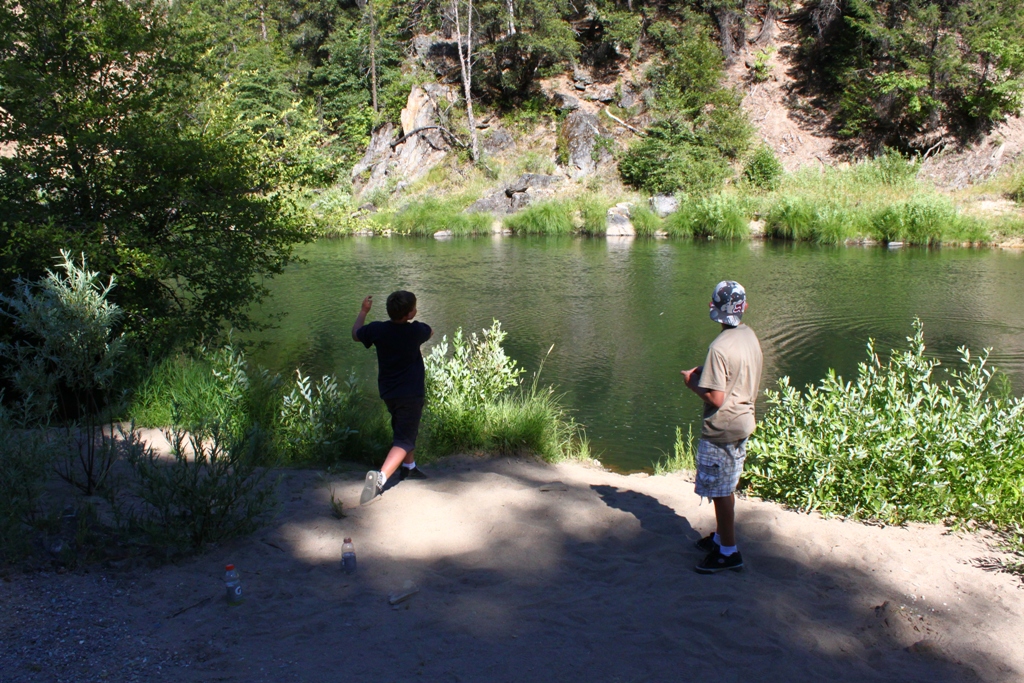
FEDERAL POWER ACT
The second legal hook for protecting rivers is the Federal Power Act as it relates to dam relicensing. The Federal Power Act goes back to 1920 and has been amended several times. The Act established the Federal Energy Regulatory Commission or FERC, which is a five-member commission appointed by the president that oversees and manages the licenses for non-federal hydroelectric plants or dams and facilities. The Commission is responsible for ensuring the health, safety, and environmental compliance of those facilities.
Mr. Wesselman explained that Shasta Dam is part of the federal Central Valley Project and so it is not under FERC’s jurisdiction. Oroville Dam is part of the State Water Project, so it is a non-federal hydropower project and is under FERC jurisdiction.
FERC has licensed over 2000 dams and hydropower facilities in the United States. Typically these are licensed for 50-year terms, and most of these dams were built and licensed before the environmental laws that were passed beginning in 1968.
“When these dams come up for relicensing, it’s a really unique and powerful opportunity to bring them up into our current reality, which means improving health and recreation and all kinds of other things,” he said.
 The Federal Power Act also identifies other state and federal agencies that have mandatory and voluntary conditioning authority in the relicensing process. That means that the State Water Board here, which oversees the implementation of the federal Clean Water Act, has mandatory conditioning authority for certain things; the same thing for the National Marine Fisheries Service and others.
The Federal Power Act also identifies other state and federal agencies that have mandatory and voluntary conditioning authority in the relicensing process. That means that the State Water Board here, which oversees the implementation of the federal Clean Water Act, has mandatory conditioning authority for certain things; the same thing for the National Marine Fisheries Service and others.
“So what they can do? They can restore natural river flows, or increase flows below a dam or releases, and that relates to improving water quality, temperature, and things such as dissolved solids and oxygen,” he said. “These agencies can provide fish passage around the dams, restore habitat, enhance recreational opportunities, and even look at dam decommissioning or removing dams. On the Klamath River, four dams are slated for removal, and that whole effort came about because of relicensing. Had those dams not come up for relicensing, the path to decommissioning would have been difficult if not impossible.”
 The slide lists some of the current projects that Friends of the River is involved in. “Oroville, believe it or not, still is not relicensed; that’s still pending and it’s gotten more complicated since the debacle with the spillway on that facility,” Mr. Wesselman said. “We’re working on the Yuba, the Tuolumne, the Merced – all of these dams are up for relicensing.”
The slide lists some of the current projects that Friends of the River is involved in. “Oroville, believe it or not, still is not relicensed; that’s still pending and it’s gotten more complicated since the debacle with the spillway on that facility,” Mr. Wesselman said. “We’re working on the Yuba, the Tuolumne, the Merced – all of these dams are up for relicensing.”
“The other FERC work that has emerged for us in the last few years is defending what’s called a 401 certification from the Trump Administration,” he continued. “They are working to weaken the Clean Water Act, and Section 401 is part of the federal Clean Water Act. It gives our State Water Board the ability to have that mandatory conditioning authority to increase instream flows, and so FERC is now granting waivers to hydropower owners and project managers for that, which is a major concern for a group like Friends of the River.”
Friends of the River is also watching the PG&E bankruptcy and what will happen to their hydro facilities; the implementation of the dams that have been relicensed such as Battle Creek, and the removal of the Klamath Dams which should be completed in the next few years.
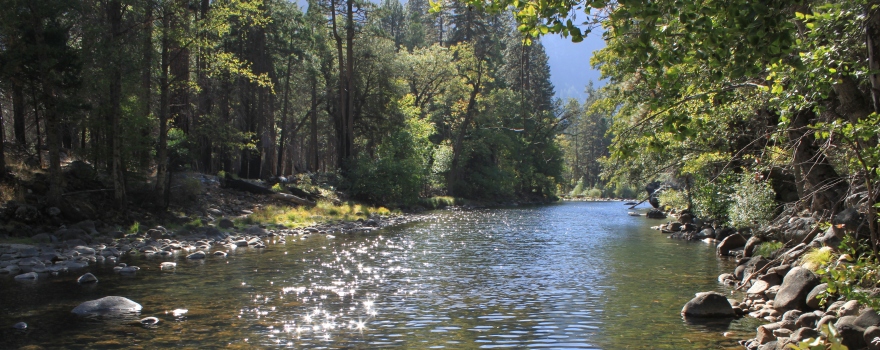
PUBLIC TRUST DOCTRINE
 The third legal hook is the public trust doctrine. It has been used less in recent history but used extremely powerfully at times, Mr. Wesselman said. The public trust doctrine has its origins rooted in Roman Law. The doctrine recognizes the public right to many shared natural resources including air, running water, the sea, and these are held in the public trust. In a larger sense, the legal doctrine requires the state to hold these resources in trust to benefit people. Typically it applies to commerce and fishing in navigable waters.
The third legal hook is the public trust doctrine. It has been used less in recent history but used extremely powerfully at times, Mr. Wesselman said. The public trust doctrine has its origins rooted in Roman Law. The doctrine recognizes the public right to many shared natural resources including air, running water, the sea, and these are held in the public trust. In a larger sense, the legal doctrine requires the state to hold these resources in trust to benefit people. Typically it applies to commerce and fishing in navigable waters.
In California, the public trust has evolved a little further, particularly through a 1971 landmark decision which expanded the application of the public trust doctrine here in California to fish, wildlife, habitat, and recreation values.
In 1983, that was reaffirmed and magnified by the Supreme Court to the Mono Lake decision. Mono Lake is a terminal lake on the east side of the Sierra; Los Angeles was diverting water from the rivers that fed that lake, and the lake was drying up, so the court ruled that Los Angeles had to restore lake levels by reducing diversions. It also required the State Water Board to take public trust into account in their planning for water resources and projects in the allocation of water resources, and take the public trust into account whenever feasible.
“Key two words though: whenever feasible,” said Mr. Wesselman.
 He then gave his thoughts on how the public trust doctrine might apply in the future. “I think about it in terms of climate change. Climate change is going to be a major disruption in water in California; we’re already seeing that. There are droughts and reduction of the snowpack, and that’s only going to magnify with time in our lifetime and beyond. That will constrain water supply, and it’s going to put these public trust values at risk, in which the state has a legal obligation to protect. And so growing water scarcity promises to increase conflict over water, and we already have plenty of that.”
He then gave his thoughts on how the public trust doctrine might apply in the future. “I think about it in terms of climate change. Climate change is going to be a major disruption in water in California; we’re already seeing that. There are droughts and reduction of the snowpack, and that’s only going to magnify with time in our lifetime and beyond. That will constrain water supply, and it’s going to put these public trust values at risk, in which the state has a legal obligation to protect. And so growing water scarcity promises to increase conflict over water, and we already have plenty of that.”
Mr. Wesselman pointed out that the State Water Board is the regulatory agency, and they have a legal obligation to protect and maintain those values; they also have the ability to change water rights and protect public trust values without it being a taking.
“As a people and as a state, we need to be thinking about this,” he continued. “Just like we need to be better prepared for things like pandemics, we need to be more prepared for the impacts of climate change that’s going to have on our state water resources and our public trust resources. I would start actually with outreach, education, and organizing. I think we need to prime the pump. People need to understand, and we want to help the public understand as well as the decision-makers and the media what’s at stake and what the state’s duties and obligations are, and how we can make it happen. How we can make it work. How we can find the through-line to make sure we have water for the people, the economy, and the environment, which are our public trust values and resources.”
There are currently some things happening to move this forward, he said. One is current litigation claiming that the State Water Board is not complying with their public trust obligations related to the San Francisco Bay-Delta and the water quality control plan update there which has gone on for more than a decade. The other issue is providing capacity for the State Water Board to do this work. They are woefully underfunded and understaffed, and that’s one of the major obstacles to them using their public trust power. Board members are appointed by the Governor, the Governor is elected, so their politics are a major factor there as well, he said.
“It’s the legislature – there has to be legislation to increase funding for the State Water Board so it has the capacity, at least in terms of the staff and money side, because the State Water Board has a duty of proof if they want to allocate water or change water rights to balance the public trust values – the duty for proof is on them.”
FOR MORE INFORMATION …
OTHER LEGAL HOOKS
There are several other legal hooks for protecting the future of water and rivers in California in the context of global climate change, such as the Endangered Species Act, the Clean Water Act, the National Environmental Policy Act, and Fish and Game Code 5937.
One that is recent is the passage of AB 1668, which establishes urban water use efficiency per capita targets, not for individuals, but for water agencies to meet.
“It’s like a renewable portfolio standard for water in a way, and so I think this is a big opening and it creates that opportunity for a through-line – meaning instead of just fighting, fish versus farmers for example, what if we figure out ways to manage water and use water more efficiently and effectively and find sustainable supplies for water so that we can create opportunities to have the water for people, for a healthy economy, and for the environment and public trust values at the same time.”
“We’re not in the 20th century or the 19th century anymore,” said Mr. Wesselman. “So let’s use 21st century solutions and technologies that are available or coming online and move the ball forward.”
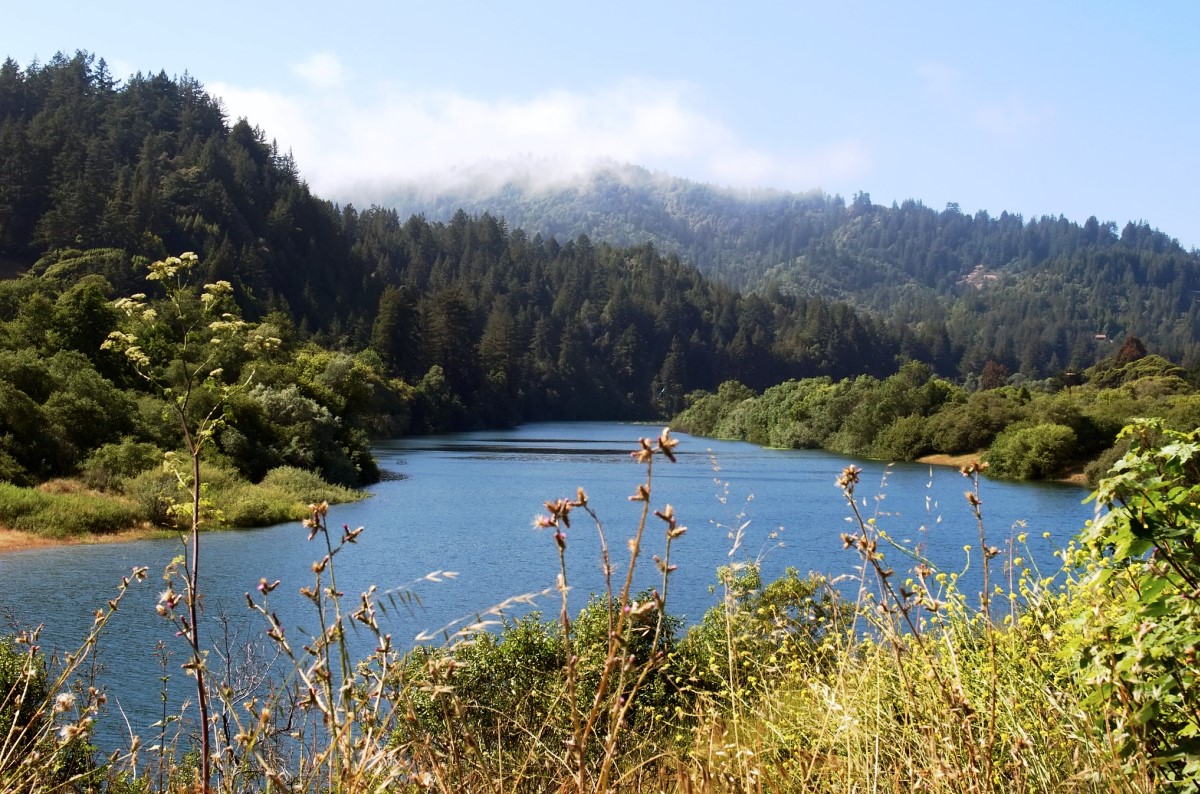
CLIMATE CHANGE AND RIVERS
 Moderator Gary Lucks asked Eric where climate change fits into the mission of preserving Wild and Scenic free-flowing rivers. Is it a help or a hindrance in light of the diminishing water supply with increasing drought severity and frequency? What about the idea of having more renewable hydro as an option in lieu of fossil fuel-based power? In light of that backdrop of climate change, what are your thoughts about the sustainability of perhaps keeping or removing dams?
Moderator Gary Lucks asked Eric where climate change fits into the mission of preserving Wild and Scenic free-flowing rivers. Is it a help or a hindrance in light of the diminishing water supply with increasing drought severity and frequency? What about the idea of having more renewable hydro as an option in lieu of fossil fuel-based power? In light of that backdrop of climate change, what are your thoughts about the sustainability of perhaps keeping or removing dams?
“Climate change is a game-changer,” Mr. Wesselman said. “It’s going to affect water perhaps more than anything else if you include sea level rise with that. But I view Wild and Scenic River Protection as a way to safeguard rivers and the watershed; although it doesn’t span the entire watershed, it sets the stage on the federal side for a management plan which includes watershed management as well. With watershed management, if we have healthy forests, we have higher water retention, so meadow restoration and fuel reduction that isn’t clear-cutting or taking the big trees. All that leads to more productivity in terms of water, a higher yield from these watersheds, so if we actually protect our watersheds or our source water, it will protect water quality and supply reliability at the same time.”
“In terms of the hydro issue, hydropower is a shrinking slice of the pie in terms of our energy portfolio in California with other truly clean and sustainable renewables coming online,” he continued. “We’re seeing a decreased emphasis on other sources such as fossils, but also hydro. Some hydro facilities are becoming uneconomic now because if they are run of the river and they can’t be ramped up or down fast, which a lot of small hydro facilities – like dozens if not over 100 owned by PG&E are that type, and they are actually having to pay to put electrons on the grid.”
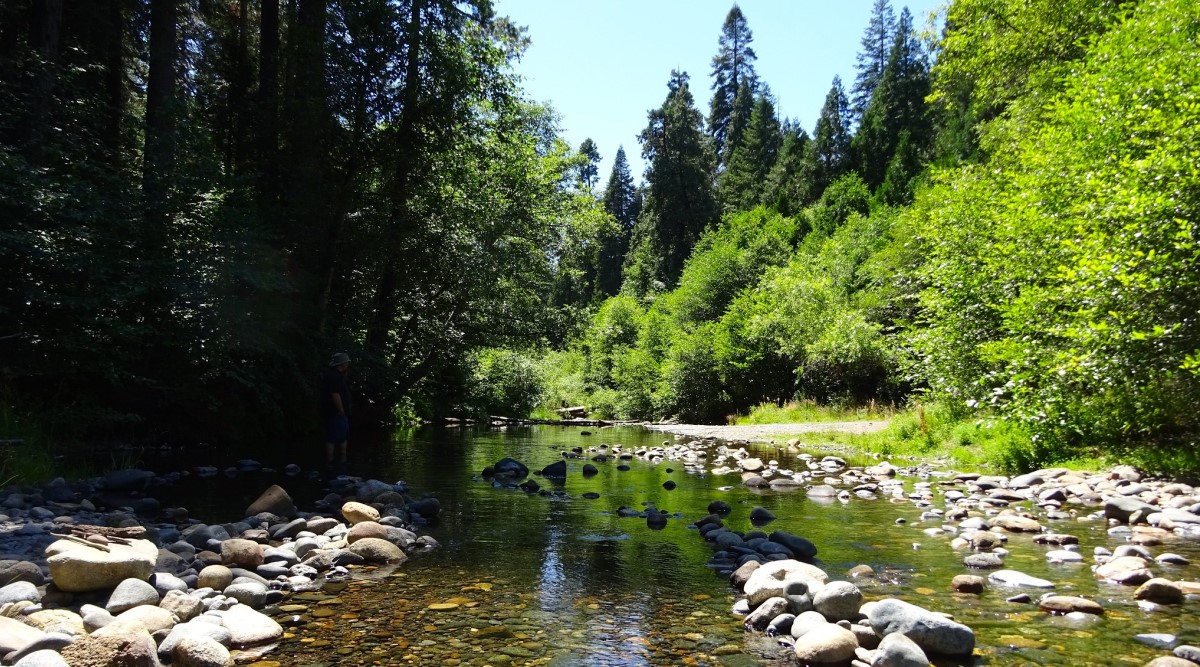
MARK DUBOIS SHARES HIS THOUGHTS
As a co-founder of Friends of the River and the International Rivers Network, Mark Dubois has long been a leader in river conservation. In 1979, he captured national headlines when he chained himself to a rock in the Stanislaus River Canyon as the New Melones Reservoir was being filled, causing the Army Corps to temporarily halt the process. While his action forced only a brief reprieve for the Stanislaus River and the reservoir was eventually filled, the growing movement to protect rivers brought a halt to major dam building in the United States.
 Mr. Dubois has continued to make his mark on the environmental movement, serving as the International Earth Day Coordinator in 1990 and again in the year 2000 when he brought together over 200 million people in 184 countries. He also coordinated ten consecutive lobbying efforts at the World Bank IFM’s annual meetings and founded an organization known as World-Wise, a grassroots campaign for international development bank reform.
Mr. Dubois has continued to make his mark on the environmental movement, serving as the International Earth Day Coordinator in 1990 and again in the year 2000 when he brought together over 200 million people in 184 countries. He also coordinated ten consecutive lobbying efforts at the World Bank IFM’s annual meetings and founded an organization known as World-Wise, a grassroots campaign for international development bank reform.
“My first and most powerful teacher in life was a river,” began Mark Dubois. “I fell in love with the Stanislaus River Canyon when I was a teenager, and that love affair transformed and changed my life. It was a very, very slow process and I still don’t have words in English to describe what the river taught me. It shared with me the most powerful lessons of my life. When somebody goes to chop off your hand, you say, ‘no, you can’t do that.’ Well, that for me the connection I had with this place; we were intertwined. So even as the words don’t make much sense, the place taught me that we are all so interconnected and intertwined, and what we do to the earth, we do to each other. What we do to each other, we do to the earth.”
“I spent a number of years on the river and slowly got swept downstream into the politics and it was much scarier facing the rapids of politics than it was the whitewater – and whitewater was very scary at times because you nearly get drowned.”
“But all that said, having lost the Stanislaus, it left me with ‘no more,’” Mr. Dubois continued. “We cannot afford to compromise any more of this sacred earth and we humans are smart enough and wise enough to find different ways. So having the privilege of starting International Rivers, it was amazing to work with colleagues all around the world who were trying to speak for their people or for their rivers. I could meet some of the most dynamic heroes of our planet back in the mid-1980s. Then I went on to have the privilege of coordinating Earth Day’s first international outreach. On one level, Earth Day, we get to learn how to celebrate it every day as in how do we live our lives with that kind of attitude, not just a one little tiny Earth Day, but the Earth Day experience.”
“People sometimes ask me, ‘how can you be optimistic?’ Well, I had the privilege of experiencing people in almost every country in the world who are following their heart and who are paying attention to what’s happening to their people or their land or their rivers, and it was extraordinary watching the outpouring of humanity showing up for Earth Day and unleashing their creativity to either educate their village or their region or their nation or interconnect with people around the world on issues they care about. So my optimism comes because, even though they don’t make headlines, there are people everywhere in the world who are striving to make a difference.”
“In terms of the state of the environment, we’ve come a long way,” Mr. Dubois continued. “When I first gathered signatures for the Stanislaus down in LA, literally within 5 minutes of getting out of my car, my eyes stung, my throat burned, and I couldn’t believe that a quarter-mile away were mountains. Well, now nobody has that experience so, in many ways, we’ve come an incredible distance. The air is cleaner than it was by far, the waters are much cleaner, there’s more swimmable water, there are less toxins in the water, and now lead paint is no more.”
“We’ve had so much progress, and yet we all have this deep, deep knowing that it’s not near enough. The consequences of what we’re doing to our forests, to our ancient forests, to all forests, to our waters, to everything on every level, to endangered species – climate change threatens all, so the state of the environment, I think most of humanity knows, no humans will have the blessings I had growing up many, many years ago.”
“Last fall, Randy Hayes and I were at an International Forests Congress. Randy started the Rainforest Action Network a year and a half before I started International Rivers, and last fall he said, ‘Mark, we’ve been doing the same thing for the last 40 years … and he didn’t quite finish, but to me, he was conveying that old line of, the definition of insanity is doing the same thing over and over again and expecting a different result.”
“So for me, the challenge that the environmental movement has is, we get to do a lot of growing. We inherited what we did. Between Rachel Carlson and my first Earth Day – look what we’re doing to our forests, our air, and our water, and people were just more and more anxious. They could feel what was going on and that was part of what precipitated 20 million Americans showing up for that first Earth Day.”
“When everyone showed up, since we’ve all been trained to be victims, we looked and we started pointing fingers,” continued Mr. Dubois. “Look at what those oil companies are doing! Look what those rapists of the forests are doing! And we didn’t want to look in the mirror and ask, did I vote for the oil company today when I filled my tank? Did I vote for the timber companies and their clear cut practices when I wanted a cheap house made of wood? I hate what chemicals are doing, but we’re voting for the chemical companies. So the challenge to me is that we inherited this system and instead of going, wow, this isn’t working, what are we going to do about it, we’re polarized and we’re divided and we’ve spent our time fighting the ‘thems’ of the world – the bad guys.”
“When Ronald Reagan was in and James Lott was threatening all of our environmental laws, clearly all of my colleagues were lamenting, ‘oh my gosh, look what we’re losing, all of these laws.’ At some point, I had this insight. In astronomy, there’s the phrase ‘retrograde motion’; all the planets go around the sun but the two planets between us and the sun, because of where they are situated, occasionally they look like they are going backward. They are never going backward, but they look like they are going backward to us and so that’s called ‘retrograde motion.’”
“So when Lott was in, as we were losing environmental laws, I’m thinking that it’s retrograde motion because we passed all of these laws on paper but we didn’t change the moral ethics. Lincoln can sign an emancipation proclamation, but he couldn’t get rid of racism and bigotry. So laws are just the beginning pointers to the direction we want to go, and yet when we don’t bring everybody with us, we lose out. So anytime I have a ‘them’ in my language, I’m going to lose out.”
“For those of you who have had the privilege of going down a river, the guide is always looking for the through-line – where is the current going, where is the best exciting run. A class 1 boater is flat water and a class 6 you don’t run because you die. Class 5 is the most exciting water that is survivable. You can still die but if you learn to read the through-line, you can survive. What makes a class 5 boater is they have to be able to see every single thing that’s out there – this huge whole that can eat everyone and the boat, and where the shred of rock just under the surface of the water, and all the little things, because if you don’t see the little things and you hit it, it will spin you to those huge obstacles that are devastating. What makes a good class 5 boater is you have to know all of that.”
“But then you put all of your attention on the through-line – where is the current going to best flow. Because if you focus on the obstacles, they become like magnets and they draw you in. When you’re paddling down together, all of you are now focused on the through-line. If somebody on the other side of the boat does something that I don’t understand, I have to trust that they can see something that I couldn’t see, or if on my side of the boat, I make a mistake, instead of having everybody waste their time yelling at me for my dumb mistake, now we’re going backward. Where is the through-line?”
“So to me, humanity, we are in the midst of a class-5 rapid,” said Mr. Dubois. “We may not make it and yet we can make it, but the only way to make it is by all of us putting our attention on where’s the through-line. We have never, ever done this before. Humanity is never been at this place before. It’s easy to be the victims to all of the ‘thems’ who see something different, but we now need all of our collective steam and we’re going to need to come together to work on it.”
“So I’ll just say that I appreciate all of you who have followed your own passion to do environmental law. We need everyone’s wisdom and insight because each of you has unique gifts and insights and I look forward to working with all of you to find a through-line for humanity at this incredible juncture we’re at right now. Thank you very much.”
WHO ARE YOUR HEROES?
Moderator Gary Lucks said, “In your early years during the battle to save the Stanislaus River and the efforts engaged establishing Friends of the River and the International Rivers Network … you got to know a number of leaders in the NGO community and players in the government, some of whom have really advanced since then. Tell us who your legal heroes are based on your experience, and what was it that set them apart?”
“There are so many heroes that I’ve had the privilege of working with and playing with, and I’m going to say what sets them apart is they’ve paid attention to their hearts and their guts,” said Mr. Dubois. “The most effective people have clearly been genius at using their mind to weave a path forward. It feels like each of the people that I can think of paid attention to something different. They didn’t follow the norms that were taught – go for where the money is, the more stuff you have, the happier you’ll be. They chose a slightly different path and many were successful financially, but what all these heroes of mine were ones that again paid attention to what serves life.”
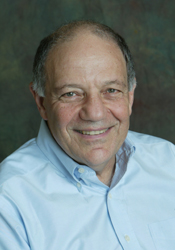
“A few heroes in the environmental realm … in the legal realm, Tom Graff was one of the founders of the Environmental Defense Fund; he was a lawyer out of Harvard. He was masterful at not just knowing the law, but there were very few laws. It was the beginning of the environmental laws but they weren’t strong. Tom was really masterful at working with the media, and he learned how to work with key people in each media and give them a lead and a story, so on the front page of the Chronicle or the Mercury or the Tribune, there would be a story. He really helped journalists advance what they were doing and advance everyone’s interest in the issues.”
“Peter Baird was probably my first legislative mentor, he was the lawyer out of Yale, and he’d gone down the river with us and he’d say, ‘when you guys give up on Jerry Brown’ – he’d lost a couple campaigns by then – he said, ‘we’ll try the legislature.’ I didn’t know if he was Republican or Democrat and at the time, I didn’t really know or care. … We hadn’t had statesmen like that before. He was a Republican that brought everyone together. He’s the one who fathered the state’s Wild and Scenic River system amongst the many, many other things he did. He really used his creativity to bring people forward, like Tom Graff. They unleash their creativity to help, even though the laws weren’t always there yet, they helped either move the existing laws or create the laws that were needed.”

“When I was just beginning, Ron Robie was this really important man who headed the State Water Resources Control Board, and in doing that, he as a lawyer, even before the public trust brought up, clearly started … crafting laws that wove in the future. That’s part of why Jerry Brown the first, anointed him to be the head of DWR. He was the first lawyer to head DWR, not an engineer who was out to only see concrete and dam the world. And with that, he brought in another mentor of mine, Jerry Meral, who creatively helped shift DWR to do water conservation, not just dam it, build it. So he really helped pioneer those things.”
“When I was doing the World Bank work, one of my mentors was Jim Barnes. He was a lawyer who had put all of his creativity for years into helping Antarctica be protected. All the countries were going for a gold rush and they wanted their piece, and he was able to help convene all these different people and have a discussion about how to protect it and put a moratorium on the strip mining.”
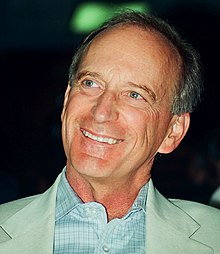
“Denis Hayes, who was my mentor, organized the first Earth Day in 1970. I joined in 1990 and in 2000 to coordinate the international outreach for Earth Day. He dropped out of law school to coordinate Earth Day and he clearly used his law degree to help pioneer renewable resources and try to help our country get on a different path.”
“Doug Ferguson is a very successful lawyer in Marin who helped protect a lot of the key open spaces in Marin and his advice 25 years ago to a friend who was much younger then, he said, ‘when you go to work for George Lucas, you could do everything he wants and you’ll get paid well and you’ll get accolades, but if you pay attention to what you know, it will serve you longer in the long run to pay attention. It will be harder, you won’t get paid as much and you won’t get as much recognition, but you’ll know you’re living in alignment.”
“It was unique that she received that kind of wisdom early on because most of us are just told, follow the money, and we forget to pay attention to our hearts, our instincts, and our guts knowing.”
“Heroes, a lot of them around.”
LOOKING FORWARD, ARE YOU OPTIMISTIC?
Question: As we reflect on five decades on Earth Day, as we look forward to the next several years towards the next decennial Earth Day, are you optimistic, and where do you think we will be in 2030?
“It changes day by day and hour by hour,” said Eric Wesselman. “There’s so much happening now. If you talk to people like Bob Wilkinson at UCSB and Martha Davis, former executive director of the Mono Lake Committee, they talk constantly as many others do about all the work that’s happening, all the on the ground projects, the restoration, and the land trust movement has come along so much over the years. Now we stand at the precipice and where do we go from here? It’s not restoration, and that’s what a lot of the on the groundwork is focused on, but I think that needs to be moved further into the policy arena where we see the public benefits and the environmental benefits as part of what can result from restoring our natural systems and the wealth that can come from that, the livability that comes with that, and the sustainability.”
“In the middle of all of this is COVID, and terrible losses in all kinds of ways, but also some little glimmers of bright spots, perhaps moments of optimism,” Mr. Wesselman continued. “I felt a little optimistic just seeing emissions going down, traffic congestion going down, and people slowing down, taking the time and reconnecting. All of this is so important and it does give me a lot of hope and optimism actually for not returning to normal but creating a new normal. Not just the COVID, but with regard to that evolving and what we get to create and what we can build on and move on and continue on from the people whose shoulders we stand on. So I’m feeling pretty optimistic.”
“This great pause is giving us a great opportunity to not rush back into the old normal that’s been wiping out the earth and steals from the future,” said Mark Dubois. “I’m optimistic, not only because of what I said earlier, but I’ve had the privilege of finding remarkable heroes in countries where there’s no democracy, no educated middle class, no resources, no nothing, and yet they are still speaking out amongst some of the worst governments. Literally they can be killed for speaking out, and yet they are speaking out.”
“The media definitely covers the horrific stuff that sort of breaks our hearts and our guts, but what doesn’t make the news is more and more people following their own inner guidance, living their lives with more integrity, and watching their own choices,” continued Mr. Dubois. “More people spending less time blaming out and trying to figure out how to be a contributor. How do I look in the mirror instead of pointing out? There’s a shift more and more to a ‘yes, we can attitude and what are we going to do.’ It’s easy to slip into being a victim; all over the world, there are these macho old men doing it in an old-style, using fear to mobilize. More and more people are learning, live, love, and figure out how do we give the world solutions and co-create a flourishing future that our grandchildren will be saying, ‘what took them so long.’”
“Lawyers have been pioneering environmental law, and there are economists who are now pioneering the heresy of growth economics, saying no, learning to mimic the earth – this earth has been flourishing for billions of years. We should get to learn how to co-create an economy that serves life and doesn’t just take from them anymore, so those things are going on. They don’t make the media much and yet they are all around us. So I too am optimistic. There’s a lot of challenges ahead, and yes, no time like the present to jump in together and find a through-line together, aim downstream, and have fun dancing.”
-
- Engineers Halt Flooding to Search for Chained-Up Protester, coverage from the Washington Post, May 23, 1979
- I’m Here to Speak for Life: River Guardian, Mark Dubois, Q&A with Mark Dubois at International Rivers
- Visit Friends of the River online by clicking here.
- The California Water Lawyers Association has a plethora of webcasts available on-demand and for CLE credit. Check out the collection here.

